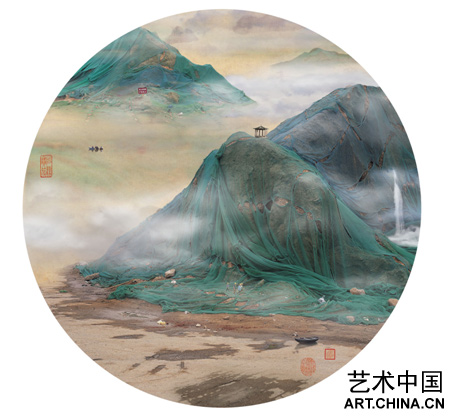|

百年印象攝影畫廊
798 PHOTO GALLERY
姚璐作品展 The Photography of Yao Lu
遮蔽與重構——新山水Concealment and Restructuring—New Mountains and Waters
遮掩就是現實的本質——姚璐的《中國景觀》
顧錚
當代中國的翻天覆地的變化,給予中國藝術家以新的刺激,激發他們的藝術感性。中國本身的豐富變化也給了藝術家以新的素材。姚璐的攝影巧妙地找到了一個屬于他自己的素材,并從此著手,展開他的當代中國風景的重建。
姚璐的《中國景觀》系列,運用高超的數碼技術,以今天的北京到處可見的一堆一堆由綠色(偶爾黑色)防塵布所遮掩的建筑材料(或垃圾)為素材,往上添加少許亭臺樓閣與小舟,拼湊成一個個看似精心構思的青綠山水畫面。但細看之下,卻會發現還有頭戴安全帽的當代民工行走于青山綠水間,驟然顯出某種時空上的不和諧。本來,按照想象與文化慣例,游走于青山綠水間的當然是士大夫與漁人樵夫,但哪里想到畫面中是頭戴安全帽的工人大步踏入風景,驚破夢幻與想象。原來,這充滿詩情畫意的畫面,來自于大興土木的當下現實,也在影射處處都在大興土木的現實。姚璐敏銳地捕捉到了當代中國的新符號:防塵布。經過他的機智運用,我們終于不得不接受這樣一個事實,那就是那些建筑工地上用來遮掩丑陋、防止揚灰、防止偷盜的綠色防塵布以及由它所披掛而成的座座土堆,已經成為了當代中國的新符號。
在這個目前開發仍然是主要著力點的國家里,綠色防塵布儼然是一種開發中的標志。一個城市,如果沒有了這一堆一堆的由防塵布遮掩起來的綠色山包與土堆,也許反而會讓人覺得不熟悉、不自然,不自信、不安全。因為這可能就說明,這個城市沒有活力,沒有受到資本的青睞,權力也沒有到位。總之,城市因為沒有開發而沒有進入現代化的進程,也就是說,這個城市沒有前途。而安全也是與開發聯系在一起,沒有開發,就意味著被遺棄,意味著落后。在這里,由綠色防塵布構成的景觀,喻示著一個城市的命運,成為了城市的新象征符號。而且這一景觀,始終處于一種動態的過程中,綠色的山包不斷出現,不斷消失。或者如垃圾那樣,不斷地出現,不斷地被移走。或者如建筑材料,不斷地被運走,又不斷地被運來。
不過,在姚璐的畫面里,一切并不像上面所說的那么直接顯然。畫面中所顯示的是,綠色所遮掩的,以及它所無法掩蔽的,這兩者所形成的一種緊張關系。這是一種掩蓋與暴露相持不下的張力狀態,而這種狀態,似乎正好是中國目前的現實。畫面中的山岡由綠色這層表皮所塑造,但又處處繃裂露餡,寓言了現實的不可揭發性。如果揭開那層綠色,就等于揭發了現實的底細。這樣的畫面讓人不得不產生這樣的聯想,在世界美麗的表皮之下,現實或者現實的素材竟然就如此的不堪入目。而現實與想象之間的共謀關系的解體,就在揭開、揭發的一瞬間。也許,從這里我們獲得的啟發是,遮掩就是現實的本質。現實如果沒有遮掩,現實本身就沒有魅力可言,而生活本身也將失去想象。這層道理,是以姚璐所呈現的破綻百出的美來提示的。畫面中的山山水水,不斷有意外的事物來戳穿這個美的虛偽與虛假,綠,顯得勉為其難,總是有那底下的泥土要來掙脫這綠色的專制,要來撕毀、破壞這個綠色的表面的和諧。整個畫面遠看和諧,近看卻處處顯示出一種左支右絀,處處透露內里的貧乏與貧困與本質上需要的遮掩。也是在這里,人們發現,遮掩也成為了一種對于現實來說是必不可少的手段,不,遮掩本身就是我們的現實了。難道這不正好影射了我們當今面臨的真實處境嗎?
不過,姚璐的這種看法,卻是以一種審美的方式表現出來。他的作品是以丑陋來營造一種美的錯覺。在轉換丑陋為審美對象時,丑陋本身在成為了一種新的審美對象的同時,也提供對于美本身的潛在的批判與反思的火藥。他從丑陋本身當中尋找審美的新世界。
稍微熟悉中國藝術史的人可能都會馬上發現,姚璐的作品挪用了宋代繪畫的風格。在今天的中國當代藝術里,挪用已經是一種司空見慣的手法。的確,美麗的宋畫,至今仍然給予藝術家以靈感,誘人與之對話。而挪用,則是與之展開對話的形式之一種。不過,他的挪用,并不是生硬的、形式的、因而也是機械的外觀的套用,而是一種機智的發揮。他與傳統對話,醉翁之意卻是在當下現在。他希望能夠讓我們通過他的作品,看到他對于現實的一種看法。
他的挪用,貫穿了一種超現實主義的立場,變現實中的物品為審美對象,從現成品中發現審美的可能性。同時,這又是后現代意義上的挪用,也就是說,傳統經過挪用得以激活,但又在賦予傳統以新的敞開的可能性的同時,也呈現了對于當下現實的一種個人評價。所有這些企圖,被姚璐集納于一個完美的古典形式中,在把現實經過PHOTOSHOP的重新合成之后,形成一個新的景觀。如果只是單單形式上的挪用,并不會對于古典與當代實踐產生新的能量置入與激勵。
姚璐的挪用當然激活了傳統,但更重要的是激活了現實,激活了對于現實的認識與想象。他與傳統對話并不僅僅停留于用自己的實踐對傳統做出一種評價,而是通過與傳統的對話發現與建立跟當下現實的新關系。他的意義在于,發現與現實重新建立聯系的可能性,居然在于傳統之中。當代藝術為了什么目的而挪用?把玩甚至玩弄傳統當然都是可以的,但如何通過傳統與現實發生并建立起一種聯系,這是姚璐的實踐給我們的新啟示。姚璐的實踐也表明,挪用不是一種停留于表象與表面的影像游戲,而是一種尋找更深地介入現實、深入到表象背后、爭取自我表達的更大自由度的新利器的過程。
Concealment Is the Essence of Reality----Yao Lu’s “Chinese Landscapes”
By Gu Zheng
The great changes that happened to contemporary China has endowed Chinese artists with new excitements that spur their artistic sense. The Changes themselves have also brought them with new materials. Yao Lu’s photography ingeniously found a material that belongs only to himself from which he began with his reconstruction of contemporary China’s landscape.
With the superb digital technique, Yao Lu’s series of “Chinese Landscapes” takes as material piles of green (occasionally black) dustproof cloth-covered construction materials (or garbage) that can be seen everywhere in today’s Beijing on which he adds pavilions and towers, making landscape paintings that seem to be carefully worked out. But with careful observation, you will find modern peasant workers with safety halmets walking between the mountains and waters, protruding a sudden disharmony of time and space. According to common imagination and culture, those who walk between the mountains and waters should be scholar officials, fishermen, and woodcutters, but in the picture, it is the workers wearing safety halmets who step into the landscape, breaking dreams and imagination. So this poetic picture comes from modern consutruction, and indicates the reality full of construction. Yao Lu keenly caught the symbol of contemporary China: dustproof cloth. Through his clever application, we finally have to accept such a truth: the green dustproof cloth for covering ugliness and preventing dust and theft and the mounds they form have become a new symbol of contemporary China.
In this country where development is still its major focus, green dustproof cloth is a sign of “under construction”. If a city does not have such green hills and piles covered by dustproof cloth, it may look unfamiliar, unnatural, inconfident, and unsafe, as it may indicate that the city lacks vigor, and is not favored by capital and power. In short, the undeveloped city has not entered modernization process, or in other words, it has no future. Safety is also linked with development. No development means being deserted and lagged behind. Therefore, the landscape formed by green dustproof cloth implies a city’s fate, and becomes the city’s new symbol.
Moreover, the landscape is always in a dynamic process in which green stacks keep appearing and disappearing; or, like garbage, keep coming and being carried away; or, like construction materials, keep being moved away and in.
However, in Yao Lu’s pictures, nothing is so direct and obvious as described above. The pictures show the concealed and the unconcealable by greenness, and the tension formed by them. This tension between concealment and exposure seems to be exactly China’s present reality. The hills in the pictures are covered by this greenness while gaps appear everywhere, implying the unrevealability of reality. Uncovering the greenness means uncovering reality. The pictures unavoidably lead us to ponder that under the world’s pretty surface, reality, or materials of reality, should be so ugly. The alliance between imagination and reality resolves right at the moment of exposure. We probably will gain the revelation that concealment is the essence of reality. Reality itself will have no charm without concealment, and life will also lose imagination. This inspiration is indicated by Yao Lu’s beauty full of breaks. The greenness looks so grudging with unexpected items piercing the false and hypocritical beauty of the mountains and waters in the pictures. The earth underneath always tries to break the dictation of the greenness and tear and destroy the green harmony on the surface. The whole picture looks harmonious from far while when observed from near, it presents inadequacy, the needy and poor inside, and the concealment that is an intrinsic necessity. It is also from here that people find that concealment has also become a necessary method. No, concealment itself is already our reality. Doesn’t it allude to the true situation we are now in?
However, Yao Lu’s opinion was expressed in an aesthetic way. His works create an illusion of beauty with ugliness. By transferring ugliness to an aesthetic target, the former provides the gun powder for possible criticism and reflection of beauty itself while becoming a new aesthetic target. He looks for a new aesthetic world from ugliness itself.
Those who know something about Chinese art history may quickly find that Yao Lu’s works draw the style of Song Dynasty’s fine art. Drawing other factors is a common method in contemporary Chinese art. Indeed, the beautiful paintings of the Song Dynasty still bring inspiration to artists today and attract their dialogues. Drawing its style is one type of the dialogues. But Yao’s drawing is not a rigid, formal, therefore machenical application; instead, it is a clever performance. He talks with tradition, but aims at the present. He expects us to see his opinion about reality through his works.
Taking an extrarealistic position, his drawing transfers real items to aesthetic targets and finds aesthetic possibilities from them. At the same time, it is a postmodern drawing, which means that it activates tradition, attaches tradition with new possible opening, and presents a personal evaluation of the present. All these purposes are collected by Yao Lu in a perfect classical form, photoshoping reality and creating a new landscape. If it were simply a formal drawing, it would not have encouraged and inserted energy into the classical and modern practice.
Of course, Yao Lu’s drawing activates tradition, but more importantly, it activates reality and the knowledge and imagination of reality. His talks with tradition do not stop at evaluating it with his own practice, but establish a new relationship with reality by the dialogues. Its meaning lies in finding that the possibility of reconnecting with reality lies in tradition. For what modern art draws other factors ? It is fine to play or even juggle with tradition, but how to bring about and set a link with reality through tradition? That is what Yao Lu’s practice inspires us to think about. His practice also shows that drawing is not a photographical game that lingers on the surface; instead, it is a process through which people search for a sharper weapon to dig into reality and the back of surface, and reach for a wider freedom of self-expression.
開幕時間:2008年6月28日15:00
展期:2008年6月28日至2008年7月
電話:010-64381784/64375284
電郵: 798@798photogallery.cn
網址:www.798photogallery.cn
地址:北京朝陽區酒仙橋路4號798工廠內大山子藝術區百年印象攝影畫廊
Opening time: June.28 3:00pm ,2008
Exhibition time:June.28,2008 –July. 2008
Tel:8610-64381784/64375284
E-mail:798@798photogallery.cn
Web:www.798photogallery.cn
Add:No4,Jiu xianqiao road,Chao Yang district, BeiJing.
DIRECTION: 798 PHOTO GALLERY

|

